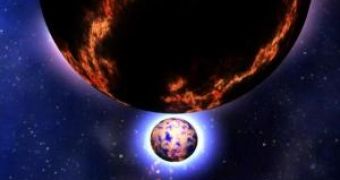GRB's, or gamma-ray bursts, are the most powerful radiation emissions released during cosmic collisions between massive objects such as neutron stars or possibly black holes. Most of the gamma-ray bursts received from the interstellar medium usually present long period bursts, which are thought to be produced by massive dead stars during the collapse of the core and the emissions of material from the upper layers, while powerful short period bursts are mostly associated to massive objects merges.
The largest such gamma-ray emission was detected in the middle of the last year, with the help of the Swift satellite and the Gemini Observatory, and the event that determined it was approximated to have taken place in a region of space about 7.4 billion light years away, over 7.4 billion years ago.
Coming from the general direction of the Taurus constellation, GRB 070714 presents a distinctive 3-second burst duration, that is associated to an emission from a cosmic collision, rather than from the explosion of a star. Optical observations conducted in order to evaluate the location of the event showed that the galaxy which the GRB originated from presents a light spectral signature identical to that of ionized oxygen and a Doppler redshift of the light spectrum of 0.92, which is equivalent to light traveling a distance of 7.4 billion light years.
Neil Gehrels from the Goddard Space Flight Center in Greenbelt says that the wide range distances of such radiation emissions are mostly determined by the short pulses of the bursts. Although 100 times more powerful than all the previously detected short period gamma-ray emissions, its total energy is extremely close to that of GRB's emitted during stellar explosions. It is currently unknown how the merging of two massive objects triggers a radiations emission ranging over vast energy levels.
An alternative explanation takes into consideration the fact that the resulted object from the merging process emits radiation in particle jets, so one of them just happened to point towards the direction of the planet Earth, making it to appear more powerful than the emission is in reality.
GRB's are mostly mysterious to astronomers since their sources haven't been accurately identified yet. A similar GRB, however less powerful, was detected in the month of February last year. Astronomers believed that the emission, coming from the general direction of the Andromeda galaxy, was the result of a merging between two neutron stars and rushed to measure the expected gravitational wave associated to the event with the LIDO instrument, but none was detected. Thus, the astronomers had to scrap the theory that the emission had been produced by a massive cosmic collision and had to come up with a more valid explanation.

 14 DAY TRIAL //
14 DAY TRIAL //